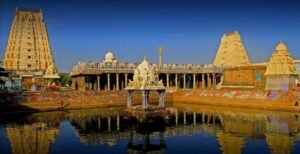The Ekambareswarar Temple (Ekambaranathar Temple) is a Hindu temple dedicated to the deity Shiva, located in the city of Kanchipuram in Tamil Nadu, India. It is significant to the Hindu sect of Saivism as one of the temples associated with the five elements, the Pancha Bhoota Stalas, and specifically the element of earth, or Prithvi. Shiva is worshiped as Ekambareswarar or Ekambaranathar, and is represented by the lingam, with his idol referred to as Prithvi lingam. His consort Parvati is represented as Elavarkuzhali. The presiding deity is revered in the 7th century Tamil Saiva canonical work, the Tevaram, written by Tamil holy poets known as the Nayanars and classified as Paadal Petra Sthalam. The temple also houses the Nilathingal Thundam Perumal temple, a Divyadesam, the 108 temples revered in the Vaishnava Nalayira Divya Prabhandam canon.
The temple complex covers 25 acres and is one of the largest in India. It houses four entrance towers known as gopurams. The tallest is the south tower, with 11 stories and a height of 58.5216 meters, making it one of the tallest temple towers in India. The temple has numerous shrines, the most prominent being those of Ekambareswarar and Nilathingal Thundam Perumal. The temple complex houses many rooms; the most notable is the thousand-pillar hall built during the Vijayanagar period.
The temple has six daily rituals at various times from 5:30 a.m. at 10 p.m., and twelve annual festivals on its calendar. The Panguni Uthiram festival celebrated for thirteen days during the Tamil month of Panguni is the most prominent festival of the temple and the city.
The present masonry structure was built during the Chola dynasty in the 9th century, while later expansions are attributed to the rulers of Vijayanagar. The temple is maintained and managed by the Hindu Religious and Charitable Endowments Department of the Government of Tamil Nadu. The temple is the largest and one of the most prominent tourist attractions in the city.
History
This vast temple is one of the oldest in India and has existed since at least 600 AD. Tamil poetry of the 2nd century AD talks about Kama kottam and Kumara kottam (currently the Kamakashi Amman temple and the Subramanya temple). The temple is mentioned in classical Tamil Sangam literature dating back to 300 BCE like Manimegalai and Perumpāṇāṟṟuppaṭai. Initially the temple was built by Pallavas. The Vedantist Kachiyapper served as a priest in the temple. The existing structure then, was demolished and rebuilt by the later Chola Kings. Adi Sankara, the 10th century saint, remodeled Kanchipuram along with the expansion of this temple along with the Kamakshi Amman temple and the Varadaraja Perumal temple with the help of local rulers.
There are inscriptions dated to AD 1532. that indicate the gift of various peoples made by Achutaraya. Vira Narasingaraya Saluva Nayaka, who was led by Achutaraya, broke the royal order by giving more land to the Ekambaranathar temple than to the Varadaraja Swamy temple against the instruction of a gift equal to any of the temples. Achutaraya hearing this equally distributed the lands to both temples.
The kings of Vijayanagar, during the 15th century, also made many contributions to the temple and later developed by Vallal Pachiyappa Mudaliar used to regularly go from Chennai to Kanchipuram to worship in this temple, he spent a significant amount of money that astonished during the British rule in the temple. renovation, Pachiyappa Mudaliar sitting on horseback can be seen on the temple pillar. At a later stage, Pachiappa Mudaliar built a similar temple with the same name Ekambareswarar in Chennai to avoid travel time to Kanchipuram. The 1905–06 Archaeological Survey of India report indicates that Nattukottai Chettiars carried out extensive renovation activities at the temple.


0 Comments